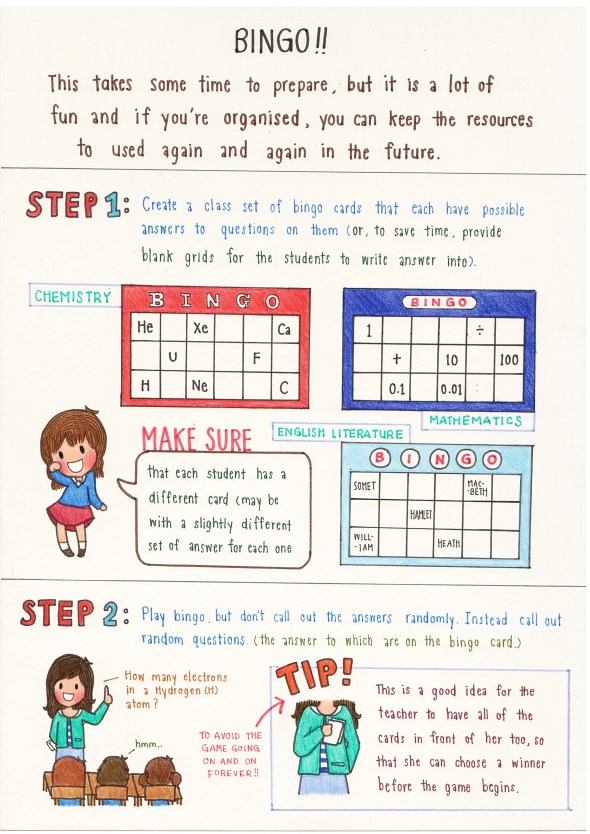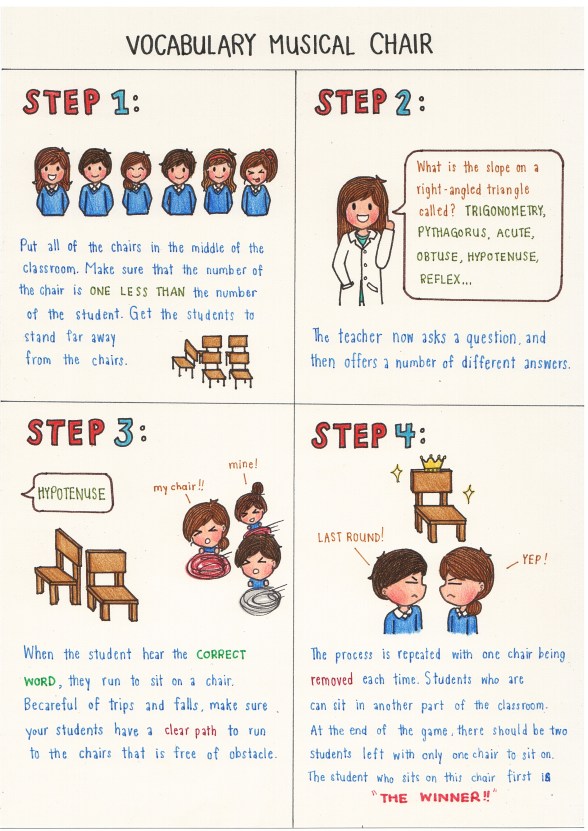An article by Richard James Rogers (Award-Winning Author of The Quick Guide to Classroom Management and The Power of Praise: Empowering Students Through Positive Feedback)
Illustrated by Pop Sutthiya Lertyongphati
He pulled me aside at the end of class as we were getting ready to go home. I had tremendous respect for my sensei and his words, though few, always hit-home hard.
“You a look a mess, Richard. Why isn’t your gi ironed”
“My mum didn’t have time to iron it today”
“Your mum shouldn’t have to iron it for you. What are you: a man or a weasel? Take responsibility for your own life. Iron your own flippin’ gi and make sure you look tidy next lesson!”
A ‘gi’ is a karate suit, just in case you didn’t know. It’s made typically of heavy cotton drill and it’s plain white. Easy to get dirty and hard to clean. Even harder to iron.
However, I wanted to win my sensei’s approval. I wanted to ‘be a man’ and take responsibility for my own karate, my own personal dress and personal presentation.
Short conversations
It’s funny when I think about it now, but that short conversation with my sensei totally changed my life. It felt like I’d gone down a peg or two in his sight and opinion.

I worked harder than ever before to train and to be the ‘perfect’ student: My gi was freshly washed and ironed every time (I asked my mum not to help – I was 11 years old and my sensei wanted me to ‘man up’).
Years later, when I went to a local karate shop to buy a new karate suit, I happened to bump into my old sensei there that same day.
“Richard, it’s flippin’ great to see you!”
“Me too, how you doing”
“I’m good. You still training?”
“Yeah I joined a Shotokan Club at uni”
“That’s flippin’ great. You know, I remember the kid who didn’t iron his gi and was very clumsy. Remember that conversation we had in the changing rooms that day?”
“Wow! Yes, sure. I remember you telling me off”
“Haha, yes. Well, I noticed a massive difference in you after that day. I was sorry to lose you when you left for uni – you were the best brown belt in the dojo”
Wow!!!
That felt good. The fact that my old sensei remembered me, and remembered our conversation. That he genuinely took an interest in me – that was inspirational.
It reminded me of who I was, which brings me to my first tip of Subtle Reinforcement.
Subtle reinforcement tip 1: Remind your students of who they are
This is different to reminding students of their achievements – it involves reminding students of their character.
As an NQT I was full of enthusiasm, as we all are. I wanted to change the world ‘one student at a time’.
Suddenly, my chance came like a clap of thunder.
Walking down the corridor one day I passed one of my Science students. He was looking very depressed, and divulged to me that his girlfriend had just dumped him.
“John, I know how you’re feeling right now. Trust me, I’ve been there. But see this as your baptism by fire. This is the moment where you realise how strong you are. This is the moment where you gain back control and focus on what you’ve been letting slide in your life. It’s her loss and your gain – now you have more time to perfect your BMX biking and become the best geographer in the whole school.”
We part as men – his fist punches mine in a sign of solidarity. The lightning begins to fork in his soul. Already his mind is tuned-in to my words. Already he starts to fight back.
He comes to class extra early, and gives 110% to each lesson. There’s a renewed respect for me as his teacher – he knows that I actually care.
Five months later his final exams are approaching and he’s getting stressed out. I ask him how his revision is going.
“To be honest, sir, it’s going badly. I’m just so stressed with it all”
To which I reciprocate: “I remember the man who who didn’t let life beat him down when his girlfriend decided to walk away. I remember the man who achieved grade As and Bs across the board and impressed everyone in school with his complete turnaround.”
Then I lower my voice.
“I remember the man who came second place in the BMX showdown at Westminster Park”
“You know about that?”
“Your mum told me”
He walks away trying his best to hide a grin that cannot be hidden. He remembers who he is. He remembers how all it took was a change of focus to create vastly different results in his life.
He went on to get 96% in his End of Year Science exam: the highest in his year group.
Reminding our students of who they are renews their faith in themselves. This can have a dramatic impact on their lives.
Subtle Reinforcement tip 2: Remind your students of their skills and achievements
We sometimes fall into the trap of thinking that the skills and achievements that students display outside of our subject areas are not relevant to us.
Nothing could be further from the truth.
Benjamin was struggling in Science class. He found experimental work difficult because his fine-motor skills were limited. His Special Educational Needs also affected his retention of written information in class.
I started an ECA at school one year – website design. It was a very simple and easy ECA – the kids picked topics they loved and basically made websites about them. Each week they would update their content and share what they had done with the group.
Benjamin signed up for that ECA and absolutely took to it like a duck to water. I was actually quite surprised – his website was by far the best in the class. He just happened to have a ‘knack’ for it.
After the Christmas break I gave Benjamin a unique task:
“Benjamin – you are now my class Online Learning Chief. This is an important responsibility which I have not handed out lightly”
“Wow. Me? Why?”
“Because you are brilliant at web design. I’ve seen your great images on your site. I remember your portfolio of Minecraft tactics that you wrote in such a comprehensive way. From now on, I want you to do all of your homework online. When you’ve built up your website to a sufficient quantity, we’ll share it with the rest of the class as a revision resource. Deal?”
“Wow. Deal”
I follow through. For once in his school life, Benjamin actually gets recognized for something valuable. This wasn’t a participation medal for turning up on Sports Day. This was recognition of something significant that Benjamin actually possesses.
He goes on to raise his achievement by two grades that year – from an E to a C. This amounts to his biggest step-up in progress he has made in school, ever.
By reminding our students of their skills and achievements, we offer them solutions to daily problems. In a similar mission to that of differentiation, we aim to inspire the inner genius through methods that appeal to each student’s learning style.
Subtle Reinforcement Tip 3: Take the time to discuss progress
A quick two-minute chat is all it takes. Bring the student to your computer and show him his grades for the year thus far.
Use this to congratulate or to offer advice for improvement.
This shows each student that you are ‘on the ball’: that you are alert to their progress and that you care about their grades.
This approach is guaranteed to have positive outcomes, if dealt with in the mood of ‘passing on information’ rather than dishing-out criticism.
Subtle Reinforcement Tip 4: Be the person you want your students to be
This is the part of the article where I must try my best not to sound like a patronizing ignoramus. I’ll have a go.
Kids notice things about us.
They notice the things we do, the way we look and the things we say, even when not spoken directly to the students who are listening.
Drawing upon our own life experiences can be a great way to get our students focussed on the right path.
The Science teacher who pulls out his vitamin box to show the students his daily supplementation for good health – this teacher is ‘living’ the subject.
The maths teacher who takes part in World Maths Day along with the students shows that maths is fun – not just something for kids to do.
The P.E. teacher who genuinely stays in shape by hitting the gym a few times per week sets an excellent example for her students to follow, and respect.
I want the very best for my students, but if my mouth is saying one thing whilst I do the exact opposite then I’ll end up becoming a laughing-stock.
That’s not a good place to be.
Student Reinforcement Tip 5: Be there when they need you to be there
My IB Chemistry students were an amazing cohort of hard-working individuals.
They needed my help a lot though.
It was not uncommon for random students to turn up at my room at lunch times and after school to seek help with questions, homework and coursework.
I could have chosen the easy option and made myself unavailable – I would certainly have gained more time and less work that way. But what’s the point in living like that?
I wanted my students to do well. I was happy to help when I could.
There was a limit, of course, and they knew that. I wasn’t prepared to stay all night and help them – I had a life of my own too. But I was prepared to stay for a significant and suitable amount of time to help them out when needed.
The results were profound – they worked harder, enjoyed the subject more and made better progress.
To be honest, I also felt a sense of satisfaction too. To me that’s the best reward of teaching – the knowledge that you’ve touched someone else’s heart. The knowledge that you’ve really made a difference.






























































































